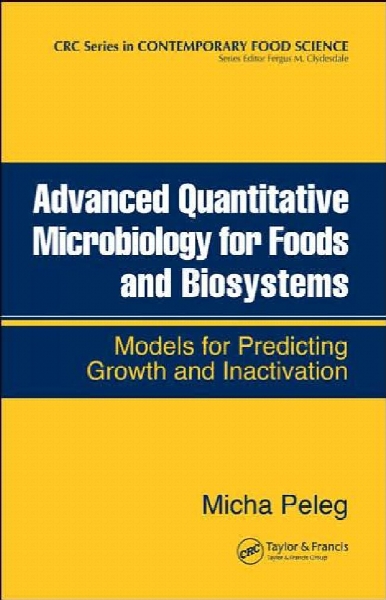Advanced quantitative microbiology for foods and biosystems : models for predicting growth and inactivation
- نوع فایل : کتاب
- زبان : انگلیسی
- مؤلف : Micha Peleg
- ناشر : Boca Raton : Taylor & Francis,
- چاپ و سال / کشور: 2006
- شابک / ISBN : 9780849336454
Description
Isothermal Microbial Heat Inactivation Primary Models -- the Traditional Approach The Survival Curve as a Cumulative Form of the Heat Distribution Resistances Secondary Models Nonisothermal Heat Inactivation The Traditional Approach The Proposed Alternative Nonisothermal Weibuillian Survival Non Weibullian Survival Models Experimental Verification of the Model Heat-Induced Chemical and Physical Changes Generating Nonisothermal Heat Inactivation Curves with Difference Equations in Real Time (Incremental Method) The Difference Equation of the Weibullian--Log Logistic Non-isothermal Survival Model Non Weibullian Survival Curves Comparison between the Continuous and Incremental Models Estimation of Microbial Survival Parameters from Nonisothermal Inactivation Data The Linear Case The Nonlinear Case Concluding Remarks Isothermal Inactivation with Stable and Dissipating Chemical Agents Chemical Inactivation under "Constant" Agent Concentration Microbial Inactivation with a Dissipating Chemical Agent Estimation of Survival Parameters from Data Obtained during Treatments with a Dissipating Agent Discrete Version of the Survival Model High CO2 and Ultrahigh Hydrostatic Pressure Preservation Microbial Inactivation under High CO2 Pressure Ultrahigh Pressure How to Use the Model Dose--Response Curves The Fermi (Logistic) Distribution The Weibull Distribution Mixed Populations Isothermal and Nonisothermal Bacterial Growth in a Closed Habitat The Traditional Models The Logistic--Fermi Combination Model Simulation of Non-isothermal Growth Patterns Using the Logistic--Fermi Model Prediction of Non-isothermal Growth Patterns from Isothermal Growth Data Interpretation of Fluctuating Microbial Count Records in Foods and Water Microbial Quality Control in a Food Plant The Origins and Nature of Microbial Count Fluctuations Asymmetry between Life and Death Estimating the Frequency of Future Outbursts -- the Principle Testing Counts Independence Uneven Rounding and Record De-rounding Choosing a Distribution Function Extinction and Absence Special Patterns Estimating Frequencies of Future Microbial High Counts or Outbursts in Foods and Water -- Case Studies Microbial Counts in a Cheese-Based Snack Rating Raw Milk Sources Frozen Foods E. coli in Wash Water of a Poultry Plant Fecal Bacteria in Lake Kinneret Characterization of Truncated Count Distributions Issues of Concern A Probabilistic Model of Historic Epidemics The Model Mortality from Smallpox and Measles in 18th Century England Potential Uses of the Model in Contemporary Epidemiology Aperiodic Microbial Outbursts with Variable Duration Microbial Fluctuations in a Water Reservoir A Model of Pathogen Outbursts in Foods Other Potential Applications of the Model Outstanding Issues and Concluding Remarks Inactivation Models Growth Models Fluctuating Records in Water and Foods A Few Last Remarks Freeware Index
Presenting a fresh view of the quantitative modeling of microbial growth and inactivation patterns in food, water and biosystems, this book describes various models to predict microbial growth and survival under a variety of conditions. It covers traditional and alternative models of thermal and non-thermal inactivation.


